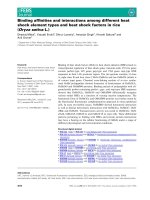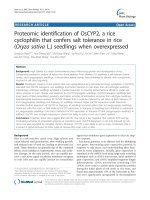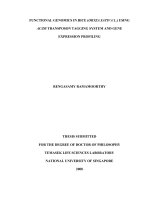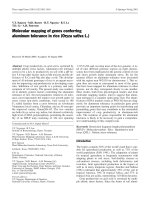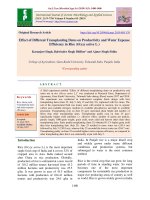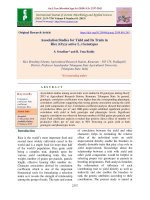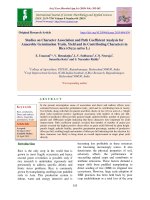Biochemical evaluation of quality parameters in rice (Oryza sativa L.)
Bạn đang xem bản rút gọn của tài liệu. Xem và tải ngay bản đầy đủ của tài liệu tại đây (370.22 KB, 8 trang )
Int.J.Curr.Microbiol.App.Sci (2019) 8(10): 237-244
International Journal of Current Microbiology and Applied Sciences
ISSN: 2319-7706 Volume 8 Number 10 (2019)
Journal homepage:
Original Research Article
/>
Biochemical Evaluation of Quality Parameters in Rice (Oryza sativa L.)
Rajesh Panchal*, Madhu Bala, Kalpesh Raval and Unnati Vaghela
Department of Genetics and Plant Breeding, NMCA, NAU, Navsari – 396 450, Gujarat, India
*Corresponding author
ABSTRACT
Keywords
Line x Tester,
Heterosis,
Combining ability,
Biochemical
parameter
Article Info
Accepted:
04 September 2019
Available Online:
10 October 2019
The above entitled experiment “Biochemical evaluation of quality
parameters in Rice (Oryza sativa L.)” was undertaken to determine the
heterosis and combining ability for different biochemical parameters from
F1 seeds of rice developed by line x tester mating design. The experiment
was conducted in kharif 2018-19 in Randomized Block Design (RBD) with
3 replications at Main Rice Research Centre, Navsari Agricultural
University, Navsari, consisting of 39 genotypes representing 7 lines, 4
testers and their resulting 28 crosses. A considerable spectrum of both the
type of heterosis i.e., relative heterosis and heterobeltiosis was recorded for
all the biochemical parameters under investigation. Whereas combining
ability analysis revealed that good general combiners and specific
combiners were observed for all the biochemical parameters included in
investigation.
2015). The world’s population is projected to
reach 9.7 billion by year 2050.
Introduction
Rice (Oryza sativa L.) belongs to the genus
Oryza, family Poaceae, was domesticated
probably in north-eastern India and southern
China about 8000 years ago and is the staple
food for more than 50% of the world’s
population (Gowda et al., 2003). It accounts
for over 20% of global calorie intake. Over
90% of the world’s rice is produced and
consumed in the Asian region with 6 countries
(China, India, Indonesia, Bangladesh, Vietnam
and Japan) accounted for 80% in the world’s
production and consumption (Abdullah et al.,
Materials and Methods
The present investigation was carried out to
elicit information on magnitude of average
heterosis and heterobeltiosis for rice yield and
its component traits. The experiment was
conducted during kharif 2018 at Main Rice
Research Centre, Navsari Agricultural
University, Navsari. The experimental
materials for present investigation consisted of
7 lines and 4 testers, which include NVSR-
237
Int.J.Curr.Microbiol.App.Sci (2019) 8(10): 237-244
391, NVSR-395, NVSR-396, NVSR-397,
NVSR-398, NVSR-2394 and NVSR-2475 as
lines, whereas NAUR-1, GNR-3, GNR-6 and
GR-4 as testers. The crossing programme was
carried out using 7 lines and 4 testers by hand
emasculation and pollination at MRRC, NAU,
Navsari during summer 2017. Total 28 crosses
were obtained through line x tester design of
mating. All the hybrid seeds and selfed
parental seeds were harvested, cleaned and
handled properly in seed bag for sowing in the
next season i.e., kharif 2018. The experiment
was laid out in a randomized complete block
design with three replications. Each entry was
planted in a single row consisting of ten plants
in each row with a spacing of 20 cm x 15 cm.
The standard agronomical practices were
followed to raise the good experimental crop.
Five competitive plants excluding border plant
were randomly selected to record the
observation on four biochemical parameters
viz., protein (%), amylose (%), zinc (ppm) and
iron (ppm).
Results and Discussion
Heterosis
The analysis of variance was performed to test
the difference among parents and hybrids for
all the biochemical parameters and is
presented in the Table 1. The results revealed
that the mean squares due to genotypes were
highly significant for all the parameters, which
indicated the considerable amount of
variability among genotypes for various
parameters. Mean squares due to genotypes
were further partitioned into parents, hybrids
and parents vs. hybrids. The difference
between parents was highly significant for all
the parameters. Among parents, mean squares
due to lines were significant for all
parameters, while in case of testers, mean
squares were found to be highly significant for
all parameters indicating the presence of wide
genetic variability among parents for all the
parameters. Mean squares due to lines vs
testers were significant for all parameters
except protein (%). Mean squares due to
parents vs. hybrids comparison were found
highly significant for all parameters indicating
potential amount of heterosis among hybrids.
The analysis of variance further revealed that
hybrids differed highly significantly for all
parameters which indicated that the
performance of hybrids were different from
that of parents thereby supporting the presence
of heterosis for all of the traits. The
phenomenon of heterosis has provided the
most important genetic tool in improving yield
of crop plants.
In present investigation, the degree of
heterosis varied from cross to cross and
parameter to parameter. For a specific
parameter, considerable high heterotic effects
were observed in certain crosses and low in
others, which revealed that nature of gene
action varied with the genetic makeup of
parents. The measures of heterosis over better
parent (heterobeltiosis) are better rational
parameters for assessing its practical utility.
Therefore, in present investigation heterosis is
reported over better parent. Positive heterosis
was considered as desirable. The present study
is an attempt to assess the possibilities of
commercial exploitation of heterosis and to
develop better varieties and elite lines for
further breeding programme.
The results in this direction are discussed in
following ways. As regards to heterosis over
mid parent a good number of crosses
registered significance in desired direction, for
different traits like days to protein (%) in 12
crosses, amylose (%) in 8 crosses, zinc (ppm)
in 12 crosses and iron (ppm) in 11 crosses. As
regards to heterosis over better parent i.e.,
heterobeltiosis, a good number of crosses
registered significant heterobeltiosis in desired
direction, for different traits like protein (%) in
8 crosses, amylose in 3 crosses, zinc (ppm) in
238
Int.J.Curr.Microbiol.App.Sci (2019) 8(10): 237-244
7 crosses and iron (ppm) in 5crosses. The
information on number of hybrids showing
significant heterosis and range of heterosis for
various parameters in rice is presented in
Table 2.
heterosis over mid parent and better parent.
Roy et al., (2009), Shinde and Patel (2014),
Mistry et al., (2015), Patel and Patel (2015),
Bano and Singh (2018) and Patel et al., (2018)
reported the similar instances.
Protein (%)
Zinc (ppm)
The results for protein content revealed that 12
crosses had significant and positive heterosis
over mid parent, while 8 crosses had
significant and positive heterosis over better
parent. The crossNVSR-395 x GNR-6 had
reported highest magnitude of both the types
of heterosis. The emphasis should be given to
these cross to develop rice varieties high
protein content by pedigree method.
Comparable harmony for this character was
also recorded by Shinde and Patel (2014),
Nayak et al., (2015), Patel and Patel (2015)
and Patel et al., (2018).
In present study, 12 crosses reported heterosis
over mid parent, whereas 7 crosses reported
heterosis over better parent for zinc content.
Highest magnitude for zinc content for
heterosis over mid parent and better parent
were exhibited by the cross NVSR-395 x
NAUR-1 and NVSR-396 x NAUR-1,
respectively. These results are in confirmation
with Patel and Patel (2015) (Table 3).
Amylose (%)
For amylose content out of 28 crosses, 8
crosses and 3 crosses exhibitedsignificant and
positive heterosis over mid parent and better
parent, respectively. The cross NVSR-398 x
GNR-3 exhibited significantly highest positive
Iron (ppm)
Total 11 hybrids manifested significant
positive heterotic effect for iron and 5 hybrids
exhibited significant positive heterobeltiosis.
The cross combination NVSR-398 x GNR-3
and NVSR-395 x NAUR-1 manifested highest
significant
relative
heterosis
and
heterobeltiosis, respectively. These results
akin with Patel and Patel (2015).
Table.1 Analysis of variance (mean sum of square) of line x tester
Sources
of
variation
Replications
Genotypes
Parents
Lines
Testers
Lines vs Testers
Parents vs hybrids
Hybrids
Error
df
2
38
10
6
3
1
1
27
76
Parameters
Protein (%)
0.05
2.70**
1.74**
2.24**
1.25**
0.22
4.93**
2.97**
0.07
Amylose (%)
0.96
11.43**
9.00**
6.10**
10.35**
22.36**
15.04**
12.19**
1.10
239
Zinc (ppm)
0.18
23.67**
29.04**
18.33**
17.67**
127.37**
36.58**
21.21**
0.30
Iron (ppm)
1.06
32.62**
43.49**
13.66**
66.89**
152.30**
150.11**
24.24**
1.43
Int.J.Curr.Microbiol.App.Sci (2019) 8(10): 237-244
Table.2 Number of hybrids showing significant heterosis and range of heterosis in rice
Parameters
Protein (%)
Amylose (%)
Zinc (ppm)
Iron (ppm)
No. of hybrids showing significant
heterosis over
Mid Parent
P (+)
N (-)
12
05
08
03
12
07
11
01
Better parent
P (+)
N (-)
08
08
03
04
07
18
05
10
Range of heterosis (%) over
Mid Parent
Better parent
-20.78 to 61.39
-13.30 to 18.94
-34.98 to 40.01
-8.19 to 21.78
-26.27 to 44.91
-18.93 to 18.15
-49.19 to 25.26
-16.44 to 15.55
Table.3 Estimation of heterosis in F1 over Mid parent (MP) and Better parent (BP)
Crosses
NVSR-391 x NAUR-1
NVSR-391 x GNR-3
NVSR-391 x GNR-6
NVSR-391 x GR-4
NVSR-395 x NAUR-1
NVSR-395 x GNR-3
NVSR-395 x GNR-6
NVSR-395 x GR-4
NVSR-396 x NAUR-1
NVSR-396 x GNR-3
NVSR-396 x GNR-6
NVSR-396 x GR-4
NVSR-397 x NAUR-1
NVSR-397 x GNR-3
NVSR-397 x GNR-6
NVSR-397 x GR-4
NVSR-398 x NAUR-1
NVSR-398 x GNR-3
NVSR-398 x GNR-6
NVSR-398 x GR-4
NVSR-2394 x NAUR-1
NVSR-2394 x GNR-3
NVSR-2394 x GNR-6
NVSR-2394 x GR 4
NVSR-2475 x NAUR-1
NVSR-2475 x GNR-3
NVSR-2475 x GNR-6
NVSR-2475 x GR-4
S.E. (d) ±
C.D. at 5%
C.D. at 1%
Range
Protein (%)
MP
BP
0.25
-1.23
-4.49
-13.00**
12.61**
4.32
-2.96
-4.32
47.16**
22.03**
50.85**
37.70**
61.39**
44.91**
19.69**
1.62
5.28
3.20
30.53**
19.45**
-20.78** -26.27**
2.20
1.28
-2.34
-8.62**
14.59**
9.73**
-13.66** -15.84**
-4.45
-8.10*
24.04**
13.55**
12.77**
10.50**
-6.15
-6.35
-0.61
-6.53
-4.25
-5.04
9.05**
-2.71
-11.01** -19.29**
11.49**
7.46*
15.33**
1.58
5.03
2.66
-19.35** -22.57**
-7.72*
-16.61**
0.19
0.21
0.37
0.43
0.49
0.57
-20.78 to -26.27 to
61.39
44.91
Amylose (%)
MP
BP
1.36
-3.54
-5.27
-6.49
-1.48
-5.84
-2.75
-4.43
-13.30** -18.93**
3.53
0.34
-3.56
-6.15
-0.14
-3.63
7.10*
-3.82
-8.20*
-14.69**
3.48
1.77
0.40
-7.08
1.99
-6.06
0.76
-3.86
3.78
2.62
3.07
-2.08
4.25
1.12
18.94**
18.15**
7.19*
0.54
7.95*
7.71*
8.72**
0.39
9.41**
4.67
-8.88*
-10.15*
13.48**
8.09*
4.68
-6.78*
1.00
-6.96
4.25
1.58
6.92*
-1.91
0.74
0.86
1.49
1.72
1.98
2.29
-13.30 to -18.93 to
18.94
18.15
240
Zinc (ppm)
MP
BP
0.72
-2.98
-27.26** -37.13**
5.85*
-6.12*
1.87
-14.16**
40.01**
23.29**
-3.58
-22.94**
26.50**
3.46
-34.98** -49.19**
32.23**
25.26**
0.63
-5.45*
-12.84** -15.73**
1.73
-7.09**
-4.96*
-12.82**
-6.38**
-9.08**
-14.5**
-14.53**
1.22
-4.55*
26.09**
21.71**
22.21**
5.83**
22.33**
8.71**
7.64**
-9.14**
27.24**
19.11**
3.19
-13.02**
-4.27
-17.27**
11.49**
-8.30**
23.43**
14.49**
-15.94** -29.71**
-3.96
-17.69**
5.86**
-13.59**
0.38
0.44
0.77
0.89
1.03
1.19
-34.98 to -49.19 to
40.01
25.26
Iron (ppm)
MP
BP
1.63
-6.76*
2.48
-10.18**
4.65
1.58
2.76
1.04
21.04**
15.55**
-8.19**
-16.44**
2.71
-4.26
0.79
-1.72
13.69**
-0.08
2.65
-13.60**
13.69**
11.66**
6.78*
0.22
-2.82
-10.07**
1.62
-10.19**
5.03
1.01
14.53**
13.67**
4.19
-8.12**
21.78**
2.83
1.66
0.22
20.39**
13.40**
3.83
-10.69**
5.42
-13.05**
17.41**
12.51**
13.23**
3.82
6.23*
-4.84
8.36**
-7.14*
1.46
1.09
3.31
-1.01
0.85
0.98
1.70
1.96
2.26
2.61
-8.19 to
-16.44 to
21.78
15.55
Int.J.Curr.Microbiol.App.Sci (2019) 8(10): 237-244
Table.4 Mean sum of squares due to general and specific combining ability
Sources of variation
1. Replications
2. Hybrids
3. Line effect
4. Tester effect
5. Line × Tester
6. Error
Estimates
σ2l
σ2t
σ2gca
σ2sca
σ2gca/σ2sca
df
Parameters
2
27
6
3
18
54
0.06
2.97**
4.96*
6.48*
1.73**
0.09
2.37
12.19**
22.76*
27.76*
6.08**
1.22
0.11
21.21**
29.49
11.92
19.99**
0.35
2.81
24.24**
6.30
104.42**
16.86**
1.25
0.41*
0.31*
0.34**
0.55**
0.62
1.80*
1.27*
1.46**
1.66**
0.88
2.43
0.55
1.24
6.57**
0.19
0.41
4.90**
3.27**
5.14**
0.64
Table.5 Estimation of General Combining Ability (GCA) effects of parents
Parents
Lines
1. NVSR 391
Protein (%)
Amylose (%)
Zinc (ppm)
Iron(ppm)
0.00
-0.41
-1.73**
-0.57
2. NVSR 395
3. NVSR 396
4. NVSR 397
5. NVSR 398
6. NVSR 2394
7. NVSR 2475
SE (Gi)
Testers
1. NAUR 1
2. GNR 3
1.19**
0.15
-0.52**
-0.10
0.16*
-0.87**
0.08
-1.15**
-1.14**
-0.18
2.79**
0.68*
-0.58
0.30
-1.39**
1.54**
0.13
2.45**
0.18
-1.17**
0.16
1.05**
-0.15
0.14
0.88*
-0.67
-0.68
0.35
0.64**
0.16**
0.92**
0.19
0.81**
-0.84**
1.14**
2.36**
3. GNR 6
4. GR 4
SE (Gj)
-0.69**
-0.11
0.06
-1.67**
0.55*
0.23
-0.40**
0.42**
0.12
-2.73**
-0.77**
0.26
241
Int.J.Curr.Microbiol.App.Sci (2019) 8(10): 237-244
Table.6 Estimation of Specific Combining Ability (SCA) effect of hybrids
Sr. No.
Crosses
Protein (%)
Amylose (%)
Zinc (ppm)
Iron (ppm)
1
2
3
4
5
6
7
8
9
10
11
12
13
14
15
16
17
18
19
20
21
22
23
24
25
NVSR-391 x NAUR-1
NVSR-391 x GNR-3
NVSR-391 x GNR-6
NVSR-391 x GR-4
NVSR-395 x NAUR-1
NVSR-395 x GNR-3
NVSR-395 x GNR-6
NVSR-395 x GR-4
NVSR-396 x NAUR-1
NVSR-396 x GNR-3
NVSR-396 x GNR-6
NVSR-396 x GR-4
NVSR-397 x NAUR-1
NVSR-397 x GNR-3
NVSR-397 x GNR-6
NVSR-397 x GR-4
NVSR-398 x NAUR-1
NVSR-398 x GNR-3
NVSR-398 x GNR-6
NVSR-398 x GR-4
NVSR-2394 x NAUR-1
NVSR-2394 x GNR-3
NVSR-2394 x GNR-6
NVSR-2394 x GR-4
NVSR-2475 x NAUR-1
-0.34*
-0.83**
1.16**
0.02
0.04
-0.30
1.23**
-0.97**
-0.19
1.07**
-1.05**
0.17
-0.33*
0.44**
-0.22
0.11
0.76**
-0.23
-0.33*
-0.20
-0.65
-0.01
-0.30
0.96**
0.71**
0.87
-0.88
0.56
-0.55
-2.30**
1.47*
0.44
0.38
1.54*
-2.07**
0.98
-0.44
0.01
-0.48
0.69
-0.21
-1.14
2.11**
-0.23
-0.74
0.79
0.67
-2.80**
1.34*
0.22
-1.51**
-2.61**
2.18**
1.95**
2.38**
-0.04
3.69**
-6.02**
2.14**
0.60
-2.95**
0.21
-2.17**
1.28**
-1.29**
2.18**
-1.72**
2.00**
0.86**
-1.14**
0.14
0.42
-1.88**
1.32**
0.75*
-0.48
0.39
0.62
-0.54
5.25**
-3.52**
-0.27
-1.47*
1.30
-1.28
1.17
-1.19
-2.28**
-0.33
0.28
2.34**
-2.38**
3.69**
-2.83**
1.53*
-1.68*
-0.56
1.90**
0.35
0.26
26
27
28
NVSR-2475 x GNR-3
NVSR-2475 x GNR-6
NVSR-2475 x GR-4
-0.14
-0.49**
-0.08
0.15
-0.82
0.37
0.22
0.61
-1.65**
-0.61
1.51**
0.31
1.61*
-0.86
-1.01
0.69
SE (Sij)
Combining ability
The analysis of variance (of combining
ability) for all the parameters was presented in
Table 4. The nature and magnitude of
estimates of genetic variance provide an idea
about the relative role of fixable and nonfixable gene effects in the inheritance of
character. This in turn helps in identifying
suitable parents for hybridization as well as
breeding method to be employed. The
variation present in the hybrids was
partitioned into portions attributable to lines,
testers and line x tester sources. Analysis of
variance for combining ability revealed that
mean squares due to females were significant
or non-significant for various parameters in
rice.
The estimation of general combining ability
(gca) variances for lines (σ2l) were significant
for protein (%) and amylose (%). In contrast,
general combining ability (gca) variances for
testers (σ2t) were significant for protein (%),
amylose (%) and iron (ppm). On the other
hand, specific combining ability (sca)
variances for line x tester interactions were
highly significant for all parameters. The
magnitude of the gca variances was lower than
sca variances for all the parameters which
242
Int.J.Curr.Microbiol.App.Sci (2019) 8(10): 237-244
indicates thepredominance of non-additive
gene action for allof the parameter. This was
further supported by low magnitude of σ2gca/
σ2sca ratios.
General combining ability effects of females
(gi) and of males (gj) as well as specific
combining ability effects of crosses (sij) for all
the parameters were also estimated.
General combining ability (GCA) and
Specific combining ability (SCA) effects
The GCA and SCAeffect of parents and their
crosses for different traits were presented in
Table 5 and Table 6, respectively. The general
combining ability is defined as the average
performance of a strain in a series of cross
combinations. Dhillon (1975) opined that
combining ability provides useful information
on the choice of parents in terms of expected
performance of the hybrids and progenies.
Singh and Harisingh (1985) and Tiwari et al.,
(1993)had also suggested that parents having
high GCA effect could produce transgressive
segregants in F2 or later generations.
Protein (%)
As regards to gca effects, 2 lines namely
NVSR-395 (1.19) and NVSR-2394 (0.16) had
significant positive gca effects. Among testers,
NAUR-1 (0.64) and GNR-3 (0.16) had
significant positive gca effects for protein.
The range of sca effect of protein in cross
combination varied from -1.05 (NVSR-396
xGNR-6) to 1.23 (NVSR-395 x GNR-6). A
total of3 crosses had significant sca effect in
desirable direction. The three top ranking
cross combinations having desirable sca effect
wereNVSR-395 x GNR-6 (1.23), NVSR-391
x GNR-6 (1.13) andNVSR-396 x GNR-3
(1.07). All the crosses which had significant
sca effects were classified as good specific
combiners for protein content.
Amylose (%)
With a view to gca effect of lines, 2 lines
namely NVSR-398 (2.79) and NVSR-2394
(0.68) possessed significant gca effects.
Besides this, testers NAUR-1 (0.92) and GR40 (0.55) had significant gca effect in
desirable direction.
As regards to sca effect of crosses, it varied
from -2.80(NVSR-2394 x GNR-6) to 2.11
(NVSR-398 x GNR-3). A cross combination
NVSR-398 x GNR-3 (2.11) had highest
significant sca effect in desirable direction
followed by NVSR-396 x NAUR-1 (1.54) and
NVSR-395 x GNR-3 (1.47).
Zinc (ppm)
Estimates of gca effect of lines revealed that
line NVSR-398 (2.45) had highly significant
and positive gca effect followed byNVSR-396
(1.54) whereas, that for testers, NAUR-1
(0.81) had highly significant and positive gca
effect followed by GR-4 (0.42).
The spectrum of sca effect of cross
combination varied from -6.02 (NVSR-395 x
GR-4) to 3.69 (NVSR-395 x GNR-6). A total
of 12 crosses had significant sca effect in
desirable direction. Out of them, NVSR-395 x
GNR-6 (3.69) had highest sca effect followed
byNVSR-395 x NAUR-1 (2.38) and NVSR391 x GNR-6 (2.18).
Iron (ppm)
The result for iron content indicated that line
NVSR-395 (1.05) had significant gca effect in
desirable direction followed by NVSR-398
(0.88). Among testers, all the 4 testers
reported significant gca effect but only 2 have
gca effect in desirable direction.
With respect to the sca effect, lowest sca
effect was possessed by cross combination
243
Int.J.Curr.Microbiol.App.Sci (2019) 8(10): 237-244
NVSR-395 x GNR-3 (-3.52) while highest sca
effect was possessed by cross combination
NVSR-395 x NAUR-1 (5.25). Out of 28 cross
combinations, 6 had significant sca effect in
desirable direction. Among them, three top
ranking cross combination were NVSR-395 x
NAUR-1 (5.25), NVSR-398 x GNR-3 (3.69)
andNVSR-397 x GR-4 (2.34).
References
Abdullah, A.; Kobayashi, H.; Matsumura, I.
and Shoichi, I. T. O. (2015). World
rice demand towards 2050: impact of
decreasing demand of per capita rice
consumption for China and India.
Research Gate, 1-18.
Bano, D. A. and Singh, S. P (2018). Heterosis
for yield and quality traits in aromatic
rice (Oryza sativa. L.) genotypes.
Current Journal of Applied Science
and Technology, 30(6): 1-18.
Gowda, M.; Venu, R. C.; Roopalakshmi, K.;
Sreerekha, M. V. and Kulkarni, R. S.
(2003). Advances in rice breeding,
genetics and genomics. Molecular
Breeding, 11: 337-353.
Mistry, P. M.; Patel, V. J.; Chaudhari, M. H.
and Desai, N. M. (2015). Heterosis and
heterobeltiosis for grain yield and yield
attributing traits in rice (Oryza sativa
L.). BIOINFOLET, 12(1B): 212–218.
Nayak. P. G.; Sreedhar. M.; Raju. C. S. and
Vanisree, S. (2015). Heterosis studies
of aromatic lines for yield and grain
quality traits in rice. International
journal of applied biology and
pharmaceutical technology, 6(1): 232239.
Patel, A.; Rathava, K.; Gajjar, P. D.; Intwala,
C. G. and Patel, P. (2018). Study of
heterosis for grain yield and its
components in aerobic rice (Oryza
sativa L.). International Journal of
Applied and Pure Bioscience, 6(6):
358-368.
Patel, R. R. and Patel, P. B. (2015). “Genetic
analysis in Rice (Oryza sativa L.)”.
Unpublished Thesis, (Department of
Genetics and Plant Breeding,) Navsari
Agricultural University, Navsari.
Roy, S. K.; Senapati, B. K.; Sinhamahapatra,
S. P. and Sarkar, K. K. (2009).
Heterosis for yield and quality traits in
rice. Oryza, 46(2): 87-93
Shinde, D. A. and Patel, P. B. (2014). Study of
heterosis for improvement in aerobic
rice
(Oryza
sativa
L.).
The
Bioscan,9(2): 739-743.
Tiwari, D. S.; Singh, V.; Shukla, P. S. and
Singh, V. (1993). Combining ability
studies in mungbean (Vigna radiata
(L.) Wilczek). Indian Journal of
Genetics
and
Plant
Breeding,
53(4):395-398.
How to cite this article:
Rajesh Panchal, Madhu Bala, Kalpesh Raval and Unnati Vaghela. 2019. Biochemical
Evaluation of Quality Parameters in Rice (Oryza sativa L.). Int.J.Curr.Microbiol.App.Sci.
8(10): 237-244. doi: />
244
